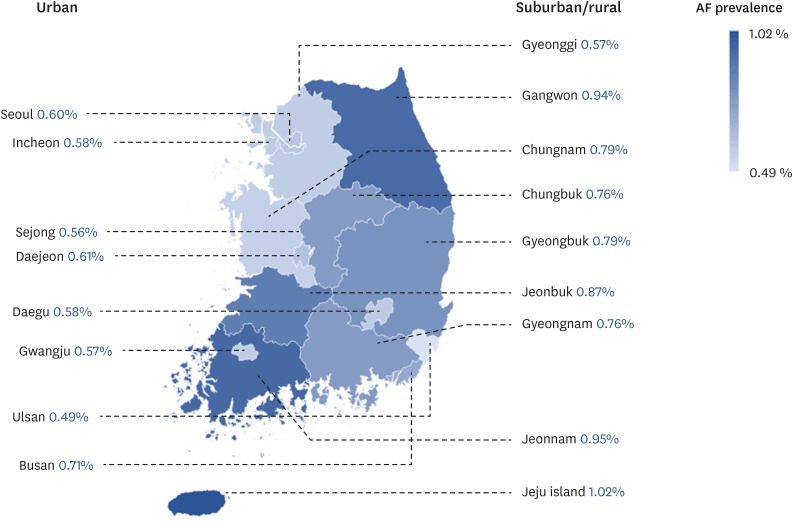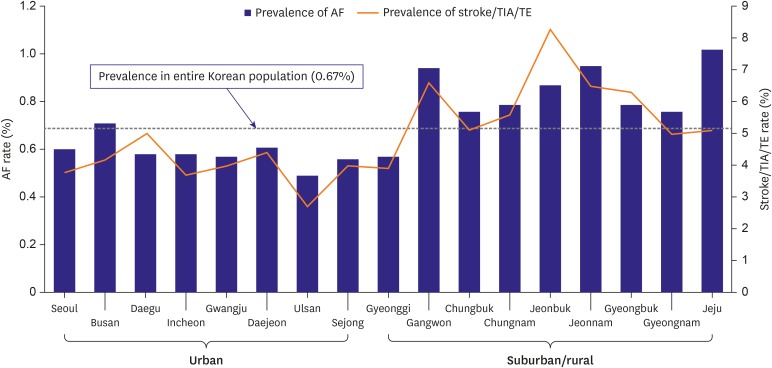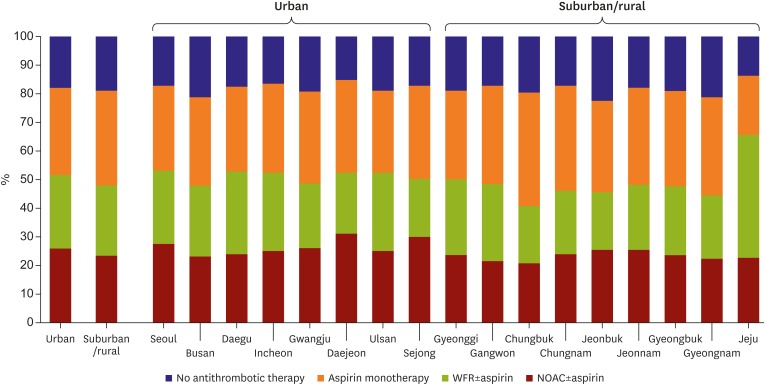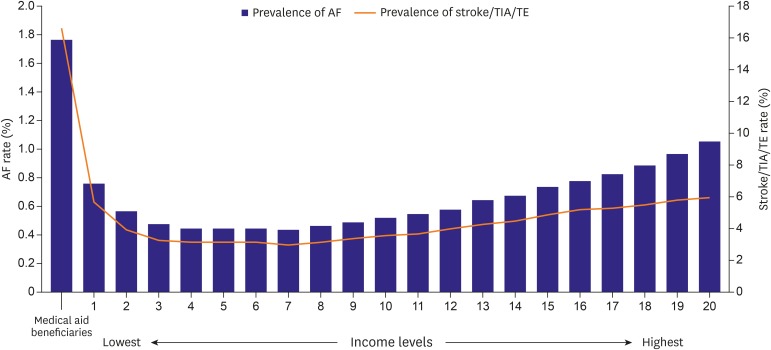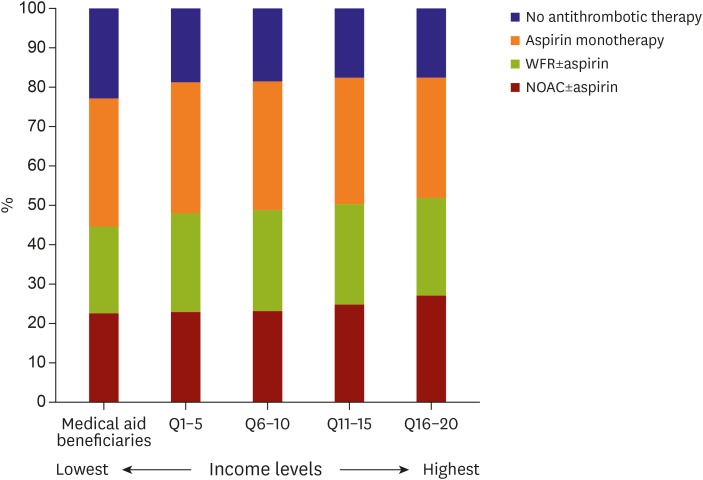Prevalence of Non-valvular Atrial Fibrillation Based on Geographical Distribution and Socioeconomic Status in the Entire Korean Population
- Affiliations
-
- 1Department of Internal Medicine, Soonchunhyang University Seoul Hospital, Seoul, Korea.
- 2Department of Internal Medicine, Seoul National University Hospital, Seoul, Korea. choiek17@snu.ac.kr
- 3Department of Biostatistics, College of Medicine, The Catholic University of Korea, Seoul, Korea.
- KMID: 2414897
- DOI: http://doi.org/10.4070/kcj.2017.0362
Abstract
- BACKGROUND AND OBJECTIVES
Prevalence of atrial fibrillation (AF) varies based on geographical location and socioeconomic status. We aimed to evaluate the prevalence of AF and utilization of antithrombotic therapy based on geographical regions and income levels in the entire Korean population.
METHODS
We performed a cross-sectional analysis of Korean adults (aged ≥20 years) using the 2015 National Health Insurance Service database (n=41,505,679). The study population was stratified into 17 geographical regions and 21 income levels.
RESULTS
We identified 276,842 patients diagnosed with AF. Overall prevalence of AF in suburban/rural regions was significantly higher than that observed in urban regions (0.72% vs. 0.61%, respectively, p < 0.001). Elderly patients (age ≥75 years) showed a higher prevalence of AF and comorbidities related to AF development showed a higher prevalence among the population residing in suburban/rural regions. Among AF patients with a CHA2DS2-VASc score ≥2, oral anticoagulation (OAC) therapy utilization was lower in the suburban/rural regions than that observed in the urban regions (48.2% vs. 51.8%, respectively, p < 0.001). The relationship between income levels and AF prevalence showed a J-shaped curve. The OAC prescription rate showed a positive correlation with income levels. Non-vitamin K antagonist oral anticoagulants tended to be more commonly prescribed among the higher income groups.
CONCLUSIONS
Geographical location of residence and income levels were closely associated with the prevalence of AF and antithrombotic therapy utilization. This information may provide further insights for more effective surveillance of AF and stroke prevention for improved clinical outcomes.
Keyword
MeSH Terms
Figure
Cited by 5 articles
-
Cardiovascular Research Using the Korean National Health Information Database
Eue-Keun Choi
Korean Circ J. 2020;50(9):754-772. doi: 10.4070/kcj.2020.0171.2018 Korean Guideline of Atrial Fibrillation Management
Boyoung Joung, Jung Myung Lee, Ki Hong Lee, Tae-Hoon Kim, Eue-Keun Choi, Woo-Hyun Lim, Ki-Woon Kang, Jaemin Shim, Hong Euy Lim, Junbeom Park, So-Ryoung Lee, Young Soo Lee, Jin-Bae Kim,
Korean Circ J. 2018;48(12):1033-1080. doi: 10.4070/kcj.2018.0339.Regional and Socioeconomic Inequality of Atrial Fibrillation with Regular Hospital Visit
Pil-Sung Yang, Boyoung Joung
Korean Circ J. 2018;48(7):635-636. doi: 10.4070/kcj.2018.0116.Stroke Prevention in Atrial Fibrillation: Focus on Asian Patients
Yan-Guang Li, So-Ryoung Lee, Eue-Keun Choi, Gregory Y.H. Lip
Korean Circ J. 2018;48(8):665-684. doi: 10.4070/kcj.2018.0190.Social Inequalities of Oral Anticoagulation after the Introduction of Non-Vitamin K Antagonists in Patients with Atrial Fibrillation
Hee Tae Yu, Pil-Sung Yang, Jinseub Hwang, Soorack Ryu, Eunsun Jang, Tae-Hoon Kim, Jae-Sun Uhm, Jong-Youn Kim, Hui-Nam Pak, Moon-Hyoung Lee, Gregory Y.H. Lip, Boyoung Joung
Korean Circ J. 2020;50(3):267-277. doi: 10.4070/kcj.2019.0207.
Reference
-
1. Chugh SS, Havmoeller R, Narayanan K, et al. Worldwide epidemiology of atrial fibrillation: a Global Burden of Disease 2010 Study. Circulation. 2014; 129:837–847. PMID: 24345399.2. Rahman F, Kwan GF, Benjamin EJ. Global epidemiology of atrial fibrillation. Nat Rev Cardiol. 2014; 11:639–654. PMID: 25113750.3. Stewart S, Murphy NF, Walker A, McGuire A, McMurray JJ. Cost of an emerging epidemic: an economic analysis of atrial fibrillation in the UK. Heart. 2004; 90:286–292. PMID: 14966048.4. Kim MH, Johnston SS, Chu BC, Dalal MR, Schulman KL. Estimation of total incremental health care costs in patients with atrial fibrillation in the United States. Circ Cardiovasc Qual Outcomes. 2011; 4:313–320. PMID: 21540439.5. Guo Y, Tian Y, Wang H, Si Q, Wang Y, Lip GY. Prevalence, incidence, and lifetime risk of atrial fibrillation in China: new insights into the global burden of atrial fibrillation. Chest. 2015; 147:109–119. PMID: 24921459.6. Tse HF, Wang YJ, Ahmed Ai-Abdullah M, et al. Stroke prevention in atrial fibrillation – an Asian stroke prespective. Heart Rhythm. 2013; 10:1082–1088. PMID: 23501173.7. Lee SR, Choi EK, Han KD, Cha MJ, Oh S. Trends in the incidence and prevalence of atrial fibrillation and estimated thromboembolic risk using the CHA2DS2-VASc score in the entire Korean population. Int J Cardiol. 2017; 236:226–231. PMID: 28233629.8. Lee H, Kim TH, Baek YS, et al. The trends of atrial fibrillation-related hospital visit and cost, treatment pattern and mortality in Korea: 10-year nationwide sample cohort data. Korean Circ J. 2017; 47:56–64. PMID: 28154592.9. Kimura K, Minematsu K, Yamaguchi T. Japan Multicenter Stroke Investigators’ Collaboration (J-MUSIC). Atrial fibrillation as a predictive factor for severe stroke and early death in 15831 patients with acute ischaemic stroke. J Neurol Neurosurg Psychiatry. 2005; 76:679–683. PMID: 15834026.10. Hart RG, Pearce LA, Aguilar MI. Meta-analysis: antithrombotic therapy to prevent stroke in patients who have nonvalvular atrial fibrillation. Ann Intern Med. 2007; 146:857–867. PMID: 17577005.11. Ruff CT, Giugliano RP, Braunwald E, et al. Comparison of the efficacy and safety of new oral anticoagulants with warfarin in patients with atrial fibrillation: a meta-analysis of randomized trials. Lancet. 2014; 383:955–962. PMID: 24315724.12. Kishore A, Vail A, Majid A, et al. Detection of atrial fibrillation after ischemic stroke or transient ischemic attack: a systematic review and meta-analysis. Stroke. 2014; 45:520–526. PMID: 24385275.13. Leyden JM, Kleinig TJ, Newbury J, et al. Adelaide stroke incidence study: declining stroke rates but many preventable cardioembolic strokes. Stroke. 2013; 44:1226–1231. PMID: 23482602.14. Kirchhof P, Benussi S, Kotecha D, et al. 2016 ESC Guidelines for the management of atrial fibrillation developed in collaboration with EACTS. Eur Heart J. 2016; 37:2893–2962. PMID: 27567408.15. Tomlin AM, Lloyd HS, Tilyard MW. Atrial fibrillation in New Zealand primary care: prevalence, risk factors for stroke and the management of thromboembolic risk. Eur J Prev Cardiol. 2017; 24:311–319. PMID: 27798365.16. Barrett TW, Self WH, Jenkins CA, et al. Predictors of regional variations in hospitalizations following emergency department visits for atrial fibrillation. Am J Cardiol. 2013; 112:1410–1416. PMID: 23972347.17. Misialek JR, Rose KM, Everson-Rose SA, et al. Socioeconomic status and the incidence of atrial fibrillation in whites and blacks: the Atherosclerosis Risk in Communities (ARIC) study. J Am Heart Assoc. 2014; 3:e001159. PMID: 25142059.18. Sjölander M, Eriksson M, Asplund K, Norrving B, Glader EL. Socioeconomic inequalities in the prescription of oral anticoagulants in stroke patients with atrial fibrillation. Stroke. 2015; 46:2220–2225. PMID: 26081841.19. Sholzberg M, Gomes T, Juurlink DN, Yao Z, Mamdani MM, Laupacis A. The influence of socioeconomic status on selection of anticoagulation for atrial fibrillation. PLoS One. 2016; 11:e0149142. PMID: 26914450.20. Andersen KK, Steding-Jessen M, Dalton SO, Olsen TS. Socioeconomic position and incidence of ischemic stroke in Denmark 2003-2012. A nationwide hospital-based study. J Am Heart Assoc. 2014; 3:e000762. PMID: 25030354.21. Chao TF, Liu CJ, Tuan TC, et al. Rate-control treatment and mortality in atrial fibrillation. Circulation. 2015; 132:1604–1612. PMID: 26384160.22. Kang SH, Choi EK, Han KD, et al. Underweight is a risk factor for atrial fibrillation: a nationwide population-based study. Int J Cardiol. 2016; 215:449–456. PMID: 27131763.23. Lee SR, Choi EK, Rhee TM, et al. Evaluation of the association between diabetic retinopathy and the incidence of atrial fibrillation: a nationwide population-based study. Int J Cardiol. 2016; 223:953–957. PMID: 27589043.24. Kang SH, Choi EK, Han KD, et al. Risk of ischemic stroke in patients with non-valvular atrial fibrillation not receiving oral anticoagulants: Korean Nationwide Population-Based Study. Circ J. 2017; 81:1158–1164. PMID: 28413184.25. Nakibuuka J, Sajatovic M, Nankabirwa J, et al. Stroke-risk factors differ between rural and urban communities: population survey in central Uganda. Neuroepidemiology. 2015; 44:156–165. PMID: 25967045.26. Modesti PA, Bamoshmoosh M, Rapi S, et al. Relationship between hypertension, diabetes and proteinuria in rural and urban households in Yemen. J Hum Hypertens. 2013; 27:572–579. PMID: 23514843.27. Huisman MV, Rothman KJ, Paquette M, et al. The changing landscape for stroke prevention in AF: findings from the GLORIA-AF registry phase 2. J Am Coll Cardiol. 2017; 69:777–785. PMID: 28209218.28. Lee IH, Kim H, Je NK. Underutilization of warfarin for stroke prophylaxis in patients with atrial fibrillation or atrial flutter in Korea. J Cardiol. 2015; 66:475–481. PMID: 26242197.29. Choi EJ, Lee IH, Je NK. Inadequate stroke prevention in Korean atrial fibrillation patients in the post-warfarin era. Int J Cardiol. 2016; 220:647–652. PMID: 27393842.
- Full Text Links
- Actions
-
Cited
- CITED
-
- Close
- Share
- Similar articles
-
- Clinical Characteristics and Management in Elderly Patients with Atrial Fibrillation
- Relation of Right Atrial Pathology to Atrial Fibrillation in Mitral Valvular Disease
- Relation between Left Atrial Size and Atrial Fibrillation
- Practical Issues to Prevent Stroke Associated with Non-valvular Atrial Fibrillation
- Pathophysiology and Diagnosis in Atrial Fibrillation

